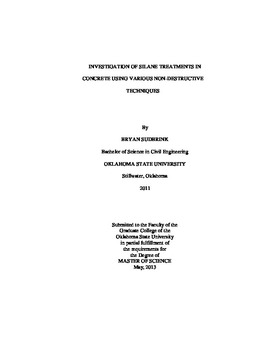| dc.contributor.author | Sudbrink, Bryan | |
| dc.date.accessioned | 2014-09-24T14:18:18Z | |
| dc.date.available | 2014-09-24T14:18:18Z | |
| dc.date.issued | 2013-05-01 | |
| dc.identifier.uri | https://hdl.handle.net/11244/11130 | |
| dc.description.abstract | Silane is commonly used on bridge decks to reduce water entry into the concrete matrix by lining pores with a hydrophobic film. This work establishes and evaluates some important non-destructive laboratory and field techniques that can be used to determine the presence and effective lifespan of silane treatments. A review of existing literature is given in order to provide a thorough understanding of silane treatments. From here, four different non-destructive techniques are investigated including Micro X-ray Fluorescence (?-XRF), the 4-Point Wenner Probe, a brominated-dye, and a chlorine-based dye. All four techniques are then compared to determine which technique is most effective in determining the presence and depth of penetration of silane in concrete. Finally, by using this technique recommendations are provided to outline the useful service life of silane as well as the ability to reapply this material. | |
| dc.format | application/pdf | |
| dc.language | en_US | |
| dc.publisher | Oklahoma State University | |
| dc.rights | Copyright is held by the author who has granted the Oklahoma State University Library the non-exclusive right to share this material in its institutional repository. Contact Digital Library Services at lib-dls@okstate.edu or 405-744-9161 for the permission policy on the use, reproduction or distribution of this material. | |
| dc.title | Investigation of Silane Coatings in Concrete Using Various Non Destructive Techniques | |
| dc.type | text | |
| osu.filename | Sudbrink_okstate_0664M_12610.pdf | |
| osu.accesstype | Open Access | |
| dc.description.department | Civil & Environmental Engineering | |
| dc.type.genre | Thesis | |
